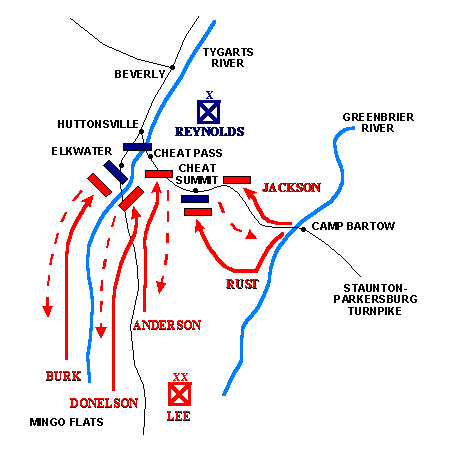LEE'S OPERATIONS
in Western Virginia
(28 July - 30 October 1861)
"It rains here all the time, literally. There has not been sunshine enough since my arrival to dry my clothes."
-- General Robert E. Lee, letter to his daughters, 29 August 1861.
"It is raining heavily. The men are all exposed on the mountain, with the enemy opposite us. We are without tents, and for two nights I have lain buttoned up in my overcoat. To-day my tent came up and I am in it. Yet I fear I shall not sleep for thinking of the poor men."
-- General Robert E. Lee, letter to Mrs. Lee from Sewell Mountain, 26 September 1861.
"... never did I experience the same heart-sinking emotions as when contemplating the wan faces and the emaciated forms of those hungry, sickly, shivering men of the army at Valley Mountain!"
--Colonel Walter H. Taylor, adjutant-general to Robert E. Lee, 1861.
"I am willing, anxious, to do and suffer anything for the cause I serve, but I cannot, nor can I consent to command in dishonor. I have not been treated with respect by General Floyd, and co-operation with him will be difficult and disagreeable, if not impossible."
-- Brigadier General Henry A. Wise, correspondence to Robert E. Lee, September, 1861.
"I solemly protest that my force is not safe under his control."
-- Brigadier General John B. Floyd, telegram to Richmond in reference to Brigadier General Henry A Wise's Independent Legion, 1861.
"The most remarkable circumstance of this campaign was, that it was conducted by a general who had never fought a battle, who had a pious horror of guerillas, and whose extreme tenderness of blood induced him to depend exclusively upon the resources of strategy to essay the achievment without the cost of life."-- Richmond Journalist, at the conclusion of Lee's western Virginia operations, 1861.
"Outwitted, outmaneuvered, and outgeneraled."
-- The Richmond Examiner, commenting on Lee's withdrawl form western Virginia, 1861.
"I am sorry that the movement of armies cannot keep pace with the expectations of newspaper editors. I know they regulate matters on paper. I wish they could do so in the field ... No one wishes them more success than I do and would be happy to give them full swing."
-- General Robert. E. Lee, letter to Mrs. Lee, 1861.
Principal Commanders
Union:
Clarksburg:
Brig. General William S. Rosecrans
Cheat Mountain:
Brig. General Joseph J. Reynolds
Colonel Nathan Kimball
Kessler's Cross Lanes:
Colonel Erastus Tyler
| |
Confederate:
Valley Head:
Major General Robert E. Lee
Camp Bartow:
Brig. General Henry R. Jackson
Colonel Albert Rust
Tygart River Valley:
Brig. General W.W. Loring
Brig. General Daniel S. Donelson
Colonel Samuel R. Anderson
Colonel Jesse S. Burk
Colonel William Gilham
Meadow Bluff:
Brig. General John B. Floyd
Sewell Mountain:
Brig. General Henry A. Wise
|
| |
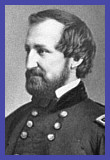
Rosecrans |
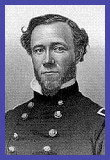
Reynolds |
|

Lee |
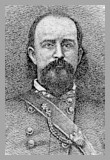
Loring |
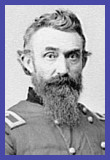
Kimball |
|

Jackson |

Rust |
| |

Floyd |
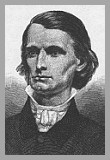
Wise |
Physical Conditions
The summer of 1861 had been particulary wet, even for a region that normally sees a great deal of rainfall. The mountain roads were muddy and useless and the streams overflowing and cold, cold enough for ice to form by the end of August. Any attempts to avoid the soggy mountain roads and turnpikes by travelling off-road through the mountain wilderness was rewarded with frustration. It meant climbing steep mountains that sometimes sloped to forty-five degrees, hacking through thickets of dense mountain laurel, and fording innumerable cold-as-ice mountain streams.
Weather conditions made it almost impossible to feed the armies. Supply wagons sunk to their hubs in mud and the Confederate commanders seriously considered abandoning their hard-fought entrenchements to move closer to the railroad. The inclimate weather also contributed significantly to heavy outbreaks of measles and fever that deprived units of sorely needed man-power. Without food and medical supplies, it was almost impossible to prevent the spread of disease or control illness.
The primary Confederate objective under these conditions, was to secure the Union-held fort atop Cheat Summit. It protected the Staunton-Parkersburg Turnpike at an elevation of almost 4,000 feet above sea level. The fort originally consisted of a large enclosed pit and parapet fortification with walls almost 14 feet high. It was believed to be impregnable to both artillery and frontal assault because it was in no small degree assisted by the terrain. The descent was precipitous and the laurel grew so dense as to be almost impenetrable.
Description of the Battles
Union forces numbered 9,000 men during the late summer of 1861, split between Cheat Mountain Summit, Elkwater, Cheat Mountain Pass, and Huttonsville. At the heavily fortified fort of Cheat Summit were elements of the 14th Indiana and the 24th and 25th Ohio Regiments. In command was Brigadier General Joseph J. Reynolds who had been a career soldier and knew Lee, having been an assistant professor of philosophy at West Point during Lee's tenure as superintendant.
From his headquarters at Valley Mountain, Major General Robert E. Lee moved troops closer onto Mingo Flats south of Valley Head, bringing the total Confederate numbers in the area to 11,000 men. Unfortunately, about half were ill, and those that were healthy were located on opposite sides of Cheat Mountain. At Camp Bartow were two brigades under Brigadier General Henry R. Jackson and Colonel Albert Rust. Men from Georgia (1st, 12th), Virginia (23rd, 31st, 37th, 44th), and Arkasas (3rd), made up the brigades. On the western side of Cheat Mountain, in the Tygert River Valley, were four brigades under Brigadier General Daniel S. Donelson, and Colonels Jesse S. Burk, William Gilham, and Samuel R. Anderson. Soldiers from North Caroilina, Tennessee, Virginia (21st, 42nd) and the Irish Battalion comprised these brigades. One hundred miles to the south were Brigadier Generals John B. Floyd and Henry A. Wise.
Floyd and Wise were sowing nothing but discord, Loring balked at almost everything that was asked of him, and the remainder of Lee's commanders were all relatively inexperienced except for Donelson, who was aging. Donelson was 60 at the time and his most recent duty had been to select two sites on the Tennessee River to build fortifications. One he named for himself and the other he named Fort Henry, and both would become the site of important Confederate defeats in February 1862. With suspect commanders, troops that had experienced only defeat, in hostile territory, and under the worst weather and terrain conditions imaginable, Lee readied to do battle.
Lee's first step was to reconnoiter the area, but even that simple task became onerous. He could not get Loring to do so, and it should have forewarned Lee of impending disaster. But the eternal diplomat, he decided to personally search out routes through the mountains that could flank the fortified Federal positions. Joining him were his son, W.H. "Rooney" Lee, who was in command of a cavalry unit under Loring, and Lee's aide, Colonel John Augustine Washington. Washington was the nephew of George Washington and owner of Mount Vernon. When the weather broke enough to allow suitable reconnaisance, Lee discovered that they could not unite the Confederate forces located on both sides of the mountain unless they attacked the fort at Cheat Summit. Rust informed Lee that he had found a pathway up the mountain from his own personal reconnaisance of Cheat Summit. It was at that point Lee decided to attack the fort, and once he did so, he rarely changed his mind. Unfortuantely, Lee had not climbed the trail to inspect it himself. It was perhaps a fatal mistake.
Lee began to plan a complex assault by five separate, but converging columns. From Camp Bartow, Rust enthusiastically asked to be given the responsibility of initiating the engagement with 1,500 men. He would follow the tail to Cheat Summit and attack from the southeast. Jackson would march along the Staunton-Parkersburg Turnpike to support him from the east, hoping to divert attention from Rust's flank movement. Anderson would attack up the Huttonsville-Huntersville Turnpike to the top of the mountain on the western side and secure posession of the Staunton-Parkersburg Turnpike there, to be in position to trap the enemy. Once Rust had secured the fort at Cheat Summit, he was to fire a cannon which would signal Donelson and Burke to rush along both sides of the Tygert River and attack Elkwater. Cavaly would shadow west of Rust to protect against any Union flanking movement, and Gilham would be held in reserve. It was a well-conceived plan, but one to which surprise was essential. And it was not well-suited to the terrain and weather conditions.
As Lee was beginning to move into position, Floyd moved down the Kanawa Valley. On 26 August 1861, He crossed the Gauley River with 2,000 Confederates and attacked Colonel Erastus Tyler's 7th Ohio Regiment encamped at Kessler's Cross Lanes. The Union forces were surprised and routed. Floyd's casualties were light, and he withdrew to the river to take up a defensive position at Carnifex Ferry. When Rosecrans learned what had happened to Tyler's command, he marched south from Clarksburg between 2-10 September with three brigades of 6,000 men. On 10 September, he attacked Floyd's entrenched position at the Henry Patteson farm that overlooked Carnifex Ferry. Rosecrans failed to breach the Confederate line, but Floyd was outnumbered and in poor position. Darkness halted the fighting, and the strength of the Union artillery convinced Floyd to withdraw during the night. Casualties were again light, but Floyd blamed the necessity for his withdrawl on Wise, who had failed to come to his aid.
Two days after Floyd vacated Carnifex Ferry, Lee finally had his columns in position. On 12 September, Rust began his trek to Cheat Summit. He started well ahead of the other columns because it would take him the longest to reach his position. Jackson moved along the pike and had his troops in position with no difficulty. Meanwhile, Anderson moved along the west side of Cheat Mountain and succeeded in securing the turnpike as it crossed the last ridge of Cheat Mountain. He had moved so silently that he suprised unsuspecting Federals in the area and captured them with a successful enveloping maneuver. Donelson and Burk remained poised to race up the Tygart River Valley. The next morning, Jackson succeeded with his diversionary tactics by worrying the enemy in front of him with only advance guard, waiting to commit his entire command until Rust was in position. All that remained was for Rust to attack and signal.
But Rust's assault was doomed from the beginning. For at least 30 miles they marched single-file through the wilderness -- climbing, hacking, and wading -- all as rain continued to pelt them. The tired and hungry troops were in miserable condition by the time they reached Cheat Summit. And instead of attacking the fort directly, Rust encountered Federal supply wagons less than a half mile from the fort. Coming to their aid was Colonel Nathan Kimball with 300 men of the 14th Indiana Regiment who were reconnoitering in the area. Rust and Kimball engaged in the dense woods. It was then that Rust lost his nerve and ordered a retreat. The men retreated willingly, throwing rifles into the dripping underbrush and littering the woods with abandoned equipment. It is not known whether Rust received faulty information from captured prisoners, or because the Federal defense was so determined. All Rust would say later was that he had become convinced he was facing an overwhelming force. In any event, the signal never came.
In the Tygert River Valley, Lee waited impatiently for the signal. Donelson's men, fearful that their powder had dampened in the ever-present rain, fired their weapons. The fussilade, combined with Jackson's need to continue demonstrating against the Federals as he waited for Rust, removed the important element of surpise. The Union forces became alarmed at the activity, prepared to meet an attack, and sent out cavalry to scout. It was one of these parties that Rooney Lee and Washington, who were reconnoitering in front of Elkwater, stumbled upon at a distance of only 20 yards. In the hurried exchange of fire Washington was killed and Lee's horse was shot out from under him. Lee was able to narrowly escape on Washington's horse. Skirmishing and maneuvering continued in the area for two more days. With surprise no longer on his side, Lee withdrew to Valley Head on 17 September.
Undaunted, Lee turned his attention south, to the bickering Floyd and Wise. After the Battle of Carnifex Ferry, Floyd had fallen back to Meadow Bluff. Wise retreated up the Kanawa Valley with him. He had been ordered by Floyd to cover the movement and follow with his command. Wise refused and took a position 10 miles west on the crest of Sewell Mountain. There the two sat and quarreled over which one held the better postion to stop the advance of Rosecrans. Into this hornets nest Lee stepped on 21 September.
With the combined forces of Rosecrans and Cox now numbering 15,000 men, Lee had to move quickly. He ordered Loring to join him, then quickly ascertained that Wise's position on Sewell Moutain was more favored. Attempting to bing harmony and quick cooperation, Lee brought all his diplomacy to bear in ordering Floyd to join Wise. Floyd did so, but his supporters saw it not only as an apparent endorsement of Wise's judgement, but also as an approval of Wise's insubordination. Lee never became directly embroiled in the controversy between the two commanders, but it was apparent that one or the other had to be removed because dissension was carrying down through the ranks. President Davis had been thinking the same thing, and not long after Lee had consolidated the armies of Wise, Floyd, and Loring on Sewell Mountain, orders arrived from Richmond relieving Wise of his command. He was given duty of equal importance, but in another theatre.
Rosecrans had dug into a defensive postion on a crest adjacent to Sewell Mountain. The armies were separated by only one deep valley. Both waited for the other to attack. Lee had decided he would attack if his adversary did not. After waiting three days, Lee found on the fourth that Rosecrans had pulled back and out of reach. Since the Federals withdrew first, it could be judged a Confederate victory. But Lee had no delusions about the fact that, as was so well-stated by his nephew, "... the scalps of Rosecrans and Reynolds [were] missing from his belt." With winter approaching, Lee was hindered by poor communications, a lack of supplies, and roads too pimitive and terrain too mountainous for serious campaigning. There was nothing left for Lee to do but pull back as well to winter quarters.
Results
- Union victory at Cheat Mountain.
- Confederate victories at Kessler's Cross Lanes and Carnifex Ferry.
Statistics
| Army |
Cross Lanes |
Carnifex Ferry |
Cheat Mountain |
|---|
| Effectives | Casualties |
Effectives | Casualties |
Effectives | Casualties |
| Union |
1,000 |
245 |
6,000 |
? |
9,000 |
80 |
| Confederate |
2,000 |
40 |
2,000 |
? |
11,000 |
90 |
| Total |
3,000 |
285 |
8,000 |
250 |
20,000 |
170 |
Notable (Mis)Fortunes of the Principals
- For his failure at Cheat Mountain, Lee was returned to an advisory position by Jefferson Davis. The southern press villified Lee, giving him the inuaspicious titles of Granny Lee and Evacuating Lee. Lee never responded to the outcry, but there is little doubt he felt the sting of the accusations. And yet, there was some justification. Lee had tried to avoid bloodshed, which was not a particularly acceptable quality in a general at that time. His strategies in the mountainous terrain and under debilitating weather conditions were too complicated. But the disparaging titles would be long forgotten within a year and he would eventually be remembered as a brilliant strategist and an audacious field commander.
- One trait that was clearly evident in his western Virginia operations, and one that would follow him throughout the war, was Lee's inability to discipline rebellious subordinate officers. It would come back to haunt him at the Battle of Gettysburg, with a timid subordinate on one wing of his army and an argumentative one on the other. Douglas Southall Freeman had this to say about Lee ...
All his life Lee had lived with gentle people, where kindly sentiments and consideration for the feelings of others were part of the noblesse oblige. In that atmosphere he was expansive, cheerful, boyant even, no matter what happened ... Now that he encountered surliness and jealousy, it repelled him, embarrassed him, and well-nigh bewildered him ... In others this might have been a virtue; in him it was a positive weakness, the first serious weakness he ever displayed as a soldier. It was a weakness that was to be apparent more than once and had to be combated, deliberately or subconciously ... The more inconsiderate such people were of him, the more considerate he was of them, and the more forebearant, up to the point where his patience failed and his temper broke bounds. Then he would freeze men quickly in the cold depths of his wrath.
- In a small twist of irony, Lee had been commissioned a full general on 31 August, just as his career was about to hit rock bottom. He had left a Major General and returned a Full General without having fought a major battle, a fact probably not lost on the southern press. He also returned with the gray beard for which he would most commonly be remembered.
- While Lee bore the brunt of the cirticism for the ineffective assault at Cheat Mountain, Rust escaped it. Colonel Walter Taylor, Lee's Adjutant General, questioned why Rust's actions were never brought up for investigation by a court of inquiry, of for trial by court-martial. But they never were. Rust remained in the mountains through the winter, and in March 1862 was promoted to Brigadier General and sent further west. Over the course of the war, his assignments carried him through Mississippi, Arkansas, and Louisiana.
- Floyd's shortcomings in western Virginia followed him through his short military career, ending with his surrender of the vital Confederate post at Fort Donelson in February 1862. The ranking commander there, he received General Ulysses S. Grant's famous Unconditional Surrender order. Vacillating, bungling an escape attempt, and then finally deciding to surrender, he infuriated Confederate Cavalry General Nathan Bedford Forrest. During the night, Forrest successfully escaped with his troops. Floyd saved himself and most of his brigade by steamboat, but left Brigadier General Simon Buckner, Floyd's subordinate, behind to surrender the bulk of the army. In March 1862, Floyd was relieved for deserting his command. His health soon faded and he died in 1863.
- Of the two bickering generals with whom Lee had to contend in western Virginia, Wise fared the better. While not a particularly successful military commander, he showed great spirit. For most of the war he served in the coastal defenses of South Carolina. Near the end of the war, he fought in the battles of Richmond, Petersburg, and Appomatox. His aggressive determination during this most trying time in the life of the Confederacy caused Confederate Major General Fitzhugh Lee to comment that "... the disheartening surrounding influences during the retreat to Appomatox had no effect on Wise ... his spirit was as unconquerable as four years before." After the war, Wise refused to restore his U.S. citizenship and was considered to be one of the last great Southern individualists at the time of his death.
- A professional soldier and veteran of the Seminole and Mexican Wars, Loring's contentious nature towards Lee would surface again. Only a few months after the Battle for Cheat Mountain, he started a feud that nearly cost the Confederacy their greatest strategist -- Major General Thomas J. "Stonewall" Jackson. After the feud was resolved, Loring was reassigned and finished his career in the western theater, where he met with a number of successes. One earned him the nickname of "Old Blizzards" while helping fend off Union General Ulysses S. Grant's efforts to reach Vicksburg. In command at Fort Pemberton on the Tallahatchie River, he strode a parapet of cotton bales exclaiming excitedly, "Give them blizzards, boys! Give them blizzards!" He fled the country after the war and lived in Egypt for 10 years. He returned to the U.S. and published A Confederate Soldier in Egypt in 1884.
- Once the furor of his shortcomings died down, Lee must have felt extremely fortunate to have participated in the campaign for western Virginia. It was here, while waiting for Rosecrans to attack his position on Sewell Mountain, that he first laid eyes on Traveller, the high-spirited horse for which Lee held great affection thoughout his life. Even when Traveller bolted from a dismounted Lee at the Battle of Second Manassas and broke both Lee's hands, the general had nothing but praise for the Greenbrier-bred horse.
Sources:
- Casdorph, Paul D. Lee and Jackson, Confederate Chieftains. 1992.
- Faust, Patricia, L., ed. Historical Times Illustrated Encyclopedia of the Civil War. 1986.
- Foote, Shelby. The Civil War, A Narrative: Vol 1. 1986.
- McPherson, James M., ed. The Atlas of the Civil War. 1994.
- Stern, Philip Van Doran. Robert E. Lee, the Man and the Soldier. 1963.
- Taylor, Walter H. Four Years with General Lee. 1962.
 |
Return to
Western Virginia |









